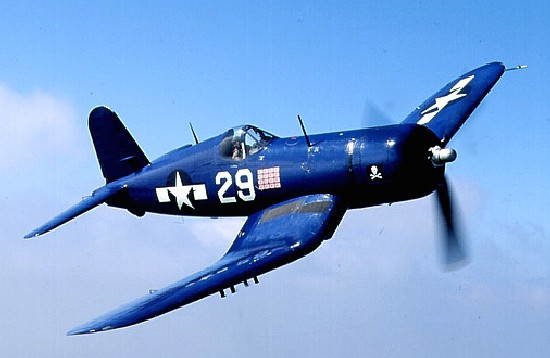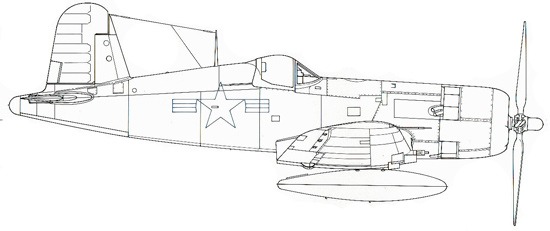The Vought F4U Corsair was developed early in 1938, at the request of the U.S. Navy. The idea was to design the smallest body compatible aircraft with the most powerful engine available. When it appeared over the Pacific Ocean waters in 1943, the Corsair was the most powerful naval aviation aircraft. It was the first U.S. single-engine fighter to exceed 400 m.p.h. Remembered for its “W”-shaped wings, it became feared by the Japanese Zero’s pilots – in the Pacific theatre alone, in the course of some 64,000 missions, Corsairs downed 2,140 enemy planes while only 189 Corsairs were lost, a ratio unmatched in the history of air warfare.
With six 12.7 mm (.50 cal) machine guns, a powerful engine and a versatile configuration, the Corsair became the symbol of American aviation in the Pacific. Many versions of this great aircraft were built during the war, the latest always being more powerful than the previous version (F4U-4 developed 450 more hp than the F4U-1).
Corsairs remained in service until 1965; total production was 12,681 aircraft.
| Type: | Single-seat, carrier-operable fighter-bomber |
| Powerplant: | One 2000 hp Pratt & Whitney 18-cylinder radial piston engine |
| Max speed: | 446 mph (718 km/h) |
| Ceiling: | 41,500 ft (12,649 m) |
| Range: | 1,005 miles (1,618 km) |
| Weight (empty): | 5,758 lbs (2,612 kg) |
| Max. T/O: | 7,952 lbs (3,607 kg) |
| Wingspan: | 38 ft 0 in (11.58 m) |
| Length: | 28 ft 9 in (8.76 m) |
| Height: | 9 ft 2 1/2 in (2.81 m) |
| Armament: | Six .50-cal. machine guns |

